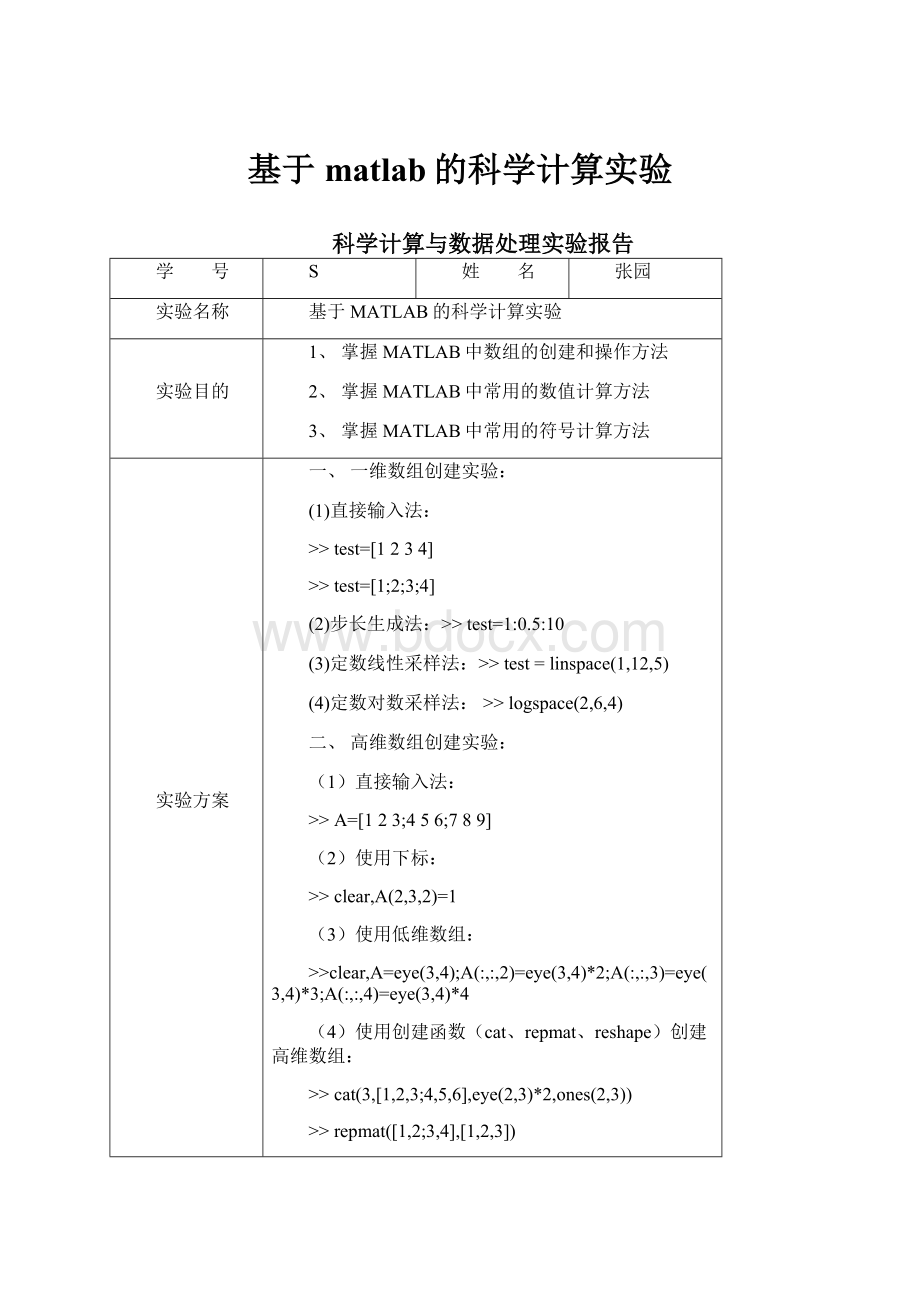基于matlab的科学计算实验.docx
《基于matlab的科学计算实验.docx》由会员分享,可在线阅读,更多相关《基于matlab的科学计算实验.docx(28页珍藏版)》请在冰豆网上搜索。

基于matlab的科学计算实验
科学计算与数据处理实验报告
学 号
S
姓 名
张园
实验名称
基于MATLAB的科学计算实验
实验目的
1、掌握MATLAB中数组的创建和操作方法
2、掌握MATLAB中常用的数值计算方法
3、掌握MATLAB中常用的符号计算方法
实验方案
一、一维数组创建实验:
(1)直接输入法:
>>test=[1234]
>>test=[1;2;3;4]
(2)步长生成法:
>>test=1:
0.5:
10
(3)定数线性采样法:
>>test=linspace(1,12,5)
(4)定数对数采样法:
>>logspace(2,6,4)
二、高维数组创建实验:
(1)直接输入法:
>>A=[123;456;789]
(2)使用下标:
>>clear,A(2,3,2)=1
(3)使用低维数组:
>>clear,A=eye(3,4);A(:
:
2)=eye(3,4)*2;A(:
:
3)=eye(3,4)*3;A(:
:
4)=eye(3,4)*4
(4)使用创建函数(cat、repmat、reshape)创建高维数组:
>>cat(3,[1,2,3;4,5,6],eye(2,3)*2,ones(2,3))
>>repmat([1,2;3,4],[1,2,3])
>>reshape(1:
20,2,5,2)
三、标准数组创建实验:
(1)全0矩阵:
>>zeros(3)
(2)全1矩阵:
>>ones(5)
(3)单位矩阵:
>>eye(4)
(4)magic矩阵:
>>magic(4)
(5)随机矩阵:
>>randn(4)
四、矩阵变换实验:
令Data=[1,2,3,4;5,6,7,8;9,10,11,12],分别使用diag、'、fliplr、flipud、rot90、tril、triu函数计算Data的对角、转置、翻转、旋转、三角矩阵,具体命令如下:
>>Data=[1,2,3,4;5,6,7,8;9,10,11,12]
>>diag(Data)
>>(Data)'
>>fliplr(Data)
>>flipud(Data)
>>rot90(Data)
>>tril(Data)
>>triu(Data)
五、字符串数组创建与操作实验:
(1)创建字符串数组:
>>arr=str2mat('I','am','a','student')
(2)去掉字符串末尾的空格deblank:
:
建立字符串,用abs函数验证空格的存在;用deblank去掉空格,用abs已经去掉空格
>>x='an';y=abs(x)
>>z=deblank(x);w=abs(z)
(3)删除字符串开头和结尾的空格strtrim
>>str1='Iamastudent';
>>str2='Iamastudent';
>>x=strtrim(str1)
>>y=strtrim(str2)
(4)执行简单的字符串替代strrep、
>>str1='Iamastudent.';
>>str2='student';
>>str3='teacher';
>>str=strrep(str1,str2,str3)
(5)规范格式strread;
>>strread('0.231','%5.3f')
(6)函数strtok找出由特定字符指定的字符串内的标记;
>>ar='Iamastudent'
>>strtok(ar,'s')
六、架构数组的创建与操作实验:
(1)直接创建法:
>>clearx;x.real=[12345];x.imag=ones(4)
(2)命令(struct)创建法
>>s=struct('name',{'x','y'},'id',{'3','4'},'w',{3,4})
(3)Fieldnames函数:
>>fieldnames(s)
(4)Getfield函数:
>>str(1,1).name='x';
>>str(1,1).ID=5;
>>str(2,1).name='y';
>>str(2,1).ID=3;
>>result=getfield(str,{2,1},'name')
(5)Setfield函数:
>>str(1,1).name='x';
>>str(1,1).ID=5;
>>str(2,1).name='y';
>>str(2,1).ID=3;
>>str=setfield(str,{2,1},'name','a');
>>str(2,1).name
七、基本运算符号实验:
(1)矩阵加:
>>a=[1,2,3;4,5,6;7,8,9];
>>b=[3,6,9;1,2,3;2,4,6];
>>a+b
(2)矩阵减:
>>a=[1,2,3;4,5,6;7,8,9];
>>b=[3,6,9;1,2,3;2,4,6];
>>a-b
(3)矩阵乘
>>a=[1,2,3;4,5,6;7,8,9];
>>b=[3,6,9;1,2,3;2,4,6];
>>a*b
(4)数组乘
>>a=[1,2,3;4,5,6;7,8,9];
>>b=[3,6,9;1,2,3;2,4,6];
>>a.*b
(5)矩阵乘方
>>a=[1,2,3;4,5,6;7,8,9];
>>a^2
(6)数组乘方
>>a=[1,2,3;4,5,6;7,8,9];
>>b=[3,6,9;1,2,3;2,4,6];
>>a.^b
(7)矩阵左除
>>a=[1,2,3;4,5,6;7,8,9];
>>b=[2;4;6];a\b
(8)矩阵右除
>>a=ones(3);
>>b=[1,1,1];
>>a/b
(9)数组左除
>>a=[1,2,3;4,5,6;7,8,9];
>>b=[3,6,9;1,2,3;2,4,6];
>>a.\b
(10)数组右除
>>a=[1,2,3;4,5,6;7,8,9];
>>b=[3,6,9;1,2,3;2,4,6];
>>a./b
(11)克罗内克张量积
>>a=[1,0,1;1,1,1;1,0,1];
>>b=[0,0,1;1,0,1;0,0,1];kron(a,b)
(12)逻辑与
>>a=[1,0,1;1,1,1;1,0,1];
>>b=[0,0,1;1,0,1;0,0,1];a&b
(13)逻辑或
>>a=[1,0,1;1,1,1;1,0,1];
>>b=[0,0,1;1,0,1;0,0,1];a|b
(14)逻辑非
>>a=[1,0,1;1,1,1;1,0,1];
>>~a
(15)逻辑异或
>>a=[1,0,1;1,1,1;1,0,1];
>>b=[0,0,1;1,0,1;0,0,1];xor(a,b)
八、矩阵分析实验:
(1)范数(norm):
>>a=[1,2,3;4,5,6;7,8,9];
>>norm(a,1)
>>norm(a,2)
(2)条件数(cond):
>>cond(a)
(3)行列式(det):
>>det(a)
(4)秩(rank):
>>rank(a)
(5)特征值(eig):
>>eig(a)
>>[V,D]=eig(a)
(6)化零矩阵(null)
>>Z=null(a)
(7)Cholesky分解(chol)
>>a=pascal(3)
>>a=pascal(3);chol(a)
(8)LU分解(lu)
>>a=[1,2,3;4,5,6;7,8,9];
>>[L1,U1]=lu(a)
(9)正交分解(qr)
>>a=[1,2,3;4,5,6;7,8,9];
>>[U,S]=qr(a)
(10)奇异值分解(svd):
>>a=[1,2,3;4,5,6;7,8,9];
>>[U,S,V]=svd(a)
九、数值计算实验:
(1)导数(diff):
>>a='x^3+4*x^2-x+20'
>>diff(a)
(2)梯度(gradient)
>>a=[1,2,3;4,5,6;7,8,9];
>>[fx,fy]=gradient(a)
(3)多项式求根(roots)、
>>p=[1,3,2,5];px=poly2str(p,'x');r=roots(p)
//p是多项式的MATLAB描述方法,我们可用poly2str(p,'x')函数,来显示多项式的形式,px=x^3+3x^2+2x+5
(4)零点(fzero、fsolve):
>>a=@(x)x^2+3*x+2;
>>x=fzero(a,0)
>>x=fsolve('x^2+3*x+2',0)
(5)极值(fminbnd、fminsearch、fminunc)、
1;>>f=@(x)x^2-4*x+5;>>fminbnd(f,0,1)
2;>>fun=inline('x
(1)^2-3*x
(1)*x
(2)+2*x
(2)^2');x0=[1,1];
>>fminsearch(fun,x0)
3;>>fun=inline('x
(1)^2-3*x
(1)*x
(2)+2*x
(2)^2');x0=[1,1];
>>fminunc(fun,x0)
(6)积分(quadl)
用内联函数定义被积函数:
>>fun=inline('-x.*x','x');
>>y=quadl(fun,0,1)
一十、符号计算实验:
(1)将
化简:
先用syms定义符号变量,再用simplify函数进行化简,具体命令如下:
>>simplify(cos(x)+sqrt(-sin(x)^2))
(2)求
的解:
用solve函数求解,命令如下:
>>x=solve('(x+2)^x=2','x')
实验记录
一、
(1)
>>test=[1234]
test=
1234
>>test=[1;2;3;4]
test=
1
2
3
4
(2)
>>test=1:
0.5:
10
test=
Columns1through4
1.00001.50002.00002.5000
Columns5through8
3.00003.50004.00004.5000
Columns9through12
5.00005.50006.00006.5000
Columns13through16
7.00007.50008.00008.5000
Columns17through19
9.00009.500010.0000
(3)
>>test=linspace(1,12,5)
test=
Columns1through4
1.00003.75006.50009.2500
Column5
12.0000
(4)
>>logspace(2,6,4)
ans=
1.0e+006*
0.00010.00220.04641.0000
二、
(1)直接输入法
>>A=[123;456;789]
A=
123
456
789
(2)使用下标
>>clear,A(2,3,2)=1
A(:
:
1)=
000
000
A(:
:
2)=
000
001
(3)使用低维数组
>>clear,A=eye(3,4);A(:
:
2)=eye(3,4)*2;A(:
:
3)=eye(3,4)*3;A(:
:
4)=eye(3,4)*4
A(:
:
1)=
1000
0100
0010
A(:
:
2)=
2000
0200
0020
A(:
:
3)=
3000
0300
0030
A(:
:
4)=
4000
0400
0040
(4)使用创建函数(cat、repmat、reshape)创建高维数组。
1,>>cat(3,[1,2,3;4,5,6],eye(2,3)*2,ones(2,3))
ans(:
:
1)=
123
456
ans(:
:
2)=
200
020
ans(:
:
3)=
111
111
2,>>repmat([1,2;3,4],[1,2,3])
ans(:
:
1)=
1212
3434
ans(:
:
2)=
1212
3434
ans(:
:
3)=
1212
3434
3,>>reshape(1:
20,2,5,2)
ans(:
:
1)=
13579
246810
ans(:
:
2)=
1113151719
1214161820
三、
(1)
>>zeros(3)
ans=
000
000
000
(2)
>>ones(5)
ans=
11111
11111
11111
11111
11111
(3)
>>eye(4)
ans=
1000
0100
0010
0001
(4)
>>magic(4)
ans=
162313
511108
97612
414151
(5)
>>randn(4)
ans=
1.06680.2944-0.6918-1.4410
0.0593-1.33620.85800.5711
-0.09560.71431.2540-0.3999
-0.83231.6236-1.59370.6900
四、
(1)
>>Data=[1,2,3,4;5,6,7,8;9,10,11,12]
Data=
1234
5678
9101112
>>diag(Data)
ans=
1
6
11
(2)
(Data)'
ans=
159
2610
3711
4812
(3)
>>fliplr(Data)
ans=
4321
8765
1211109
(4)
>>flipud(Data)
ans=
9101112
5678
1234
(5)
>>rot90(Data)
ans=
4812
3711
2610
159
(6)
>>tril(Data)
ans=
1000
5600
910110
(7)
>>triu(Data)
ans=
1234
0678
001112
五、
(1)
>>arr=str2mat('I','am','a','student')
arr=
I
am
a
student
(2)
>>x='an';y=abs(x)
y=
973211032
>>z=deblank(x);w=abs(z)
w=
9732110
(3)
>>str1='Iamastudent';
>>str2='Iamastudent';
>>x=strtrim(str1)
x=
Iamastudent
>>y=strtrim(str2)
y=
Iamastudent
(4)
>>str1='Iamastudent.';
>>str2='student';
>>str3='teacher';
>>str=strrep(str1,str2,str3)
str=
Iamateacher.
(5)
>>strread('0.231','%5.3f')
ans=
0.2310
(6)
>>ar='Iamastudent'
ar=
Iamastudent
>>strtok(ar,'s')
ans=
Iama
六;
(1)直接法
>>clearx;x.real=[12345];x.imag=ones(4)
x=
real:
[12345]
imag:
[4x4double]
(2)struct函数
>>s=struct('name',{'x','y'},'id',{'3','4'},'w',{3,4})
s=
1x2structarraywithfields:
name
id
w
(3)fieldnames功能演示
>>fieldnames(s)
ans=
'name'
'id'
'w'
(4)getfield功能演示
>>str(1,1).name='x';
>>str(1,1).ID=5;
>>str(2,1).name='y';
>>str(2,1).ID=3;
>>result=getfield(str,{2,1},'name')
result=
y
(5)setfield功能演示
>>str(1,1).name='x';
>>str(1,1).ID=5;
>>str(2,1).name='y';
>>str(2,1).ID=3;
>>str=setfield(str,{2,1},'name','a');
>>str(2,1).name
ans=
a
七:
(1)矩阵加
>>a=[1,2,3;4,5,6;7,8,9];
>>b=[3,6,9;1,2,3;2,4,6];
>>a+b
ans=
4812
579
91215
(2)矩阵减
>>a=[1,2,3;4,5,6;7,8,9];
>>b=[3,6,9;1,2,3;2,4,6];
>>a-b
ans=
-2-4-6
333
543
(3)矩阵乘
>>a=[1,2,3;4,5,6;7,8,9];
>>b=[3,6,9;1,2,3;2,4,6];
>>a*b
ans=
112233
295887
4794141
(4)数组乘
>>a=[1,2,3;4,5,6;7,8,9];
>>b=[3,6,9;1,2,3;2,4,6];
>>a.*b
ans=
31227
41018
143254
(5)矩阵乘方
>>a=[1,2,3;4,5,6;7,8,9];
>>a^2
ans=
303642
668196
102126150
(6)数组乘方
>>a=[1,2,3;4,5,6;7,8,9];
>>b=[3,6,9;1,2,3;2,4,6];
>>a.^b
ans=
16419683
425216
494096531441
(7)矩阵左除
>>a=[1,2,3;4,5,6;7,8,9];
>>b=[2;4;6];a\b
Warning:
Matrixisclosetosingularorbadlyscaled.
Resultsmaybeinaccurate.RCOND=2.203039e-018.
ans=
-0.4667
0.9335
0.1999
(8)矩阵右除
>>a=ones(3);
>>b=[1,1,1];
>>a/b
ans=
1
1
1
(9)数组左除
>>a=[1,2,3;4,5,6;7,8,9];
>>b=[3,6,9;1,2,3;2,4,6];
>>a.\b
ans=
3.00003.00003.0000
0.25000.40000.5000
0.28570.50000.6667
(10)数组右除
>>a=[1,2,3;4,5,6;7,8,9];
>>b=[3,6,9;1,2,3;2,4,6];
>>a./b
ans=
0.33330.33330.3333
4.00002.50002.0000
3.50002.00001.5000
(11)克罗内克张量积
>>a=[1,0,1;1,1,1;1,0,1];
>>b=[0,0,1;1,0,1;0,0,1];kron(a,b)
ans=
001000001
101000101
001000001
001001001
101101101
001001001
001000001
101000101
001000001
(12)逻辑与
>>a=[1,0,1;1,1,1;1,0,1];
>>b=[0,0,1;1,0,1;0,0,1];a&b
ans=
001
101
001
(13)逻辑或
>>a=[1,0,1;1,1,1;1,0,1];
>>b=[0,0,1;1,0,1;0,0,1];a|b
ans=
101
111
101
(14)逻辑非
>>a=[1,0,1;1,1,1;1,0,1];
>>~a
ans=
010
000
010
(15)逻辑异或
>>a=[1,0,1;1,1,1;1,0,1];
>>b=[0,0,1;1,0,1;0,0,1];xor(a,b)
ans=
100
010
100
八、
(1)范数(norm)用来度量矩阵或者向量在某种意义下的长度
>>a=[1,2,3;4,5,6;7,8,9];
>>norm(a,1)
ans=
18
>>norm(a,2)
ans=
16.8481
(2)条件数(cond)可以描述矩阵为良性矩阵还是病态矩阵的一个参数
>>cond(a)
ans=
5.0524e+016
(3)行列式(det)
>>det(a)
ans=
0
(4)秩(rank)
>>rank(a)
ans=
2
(5